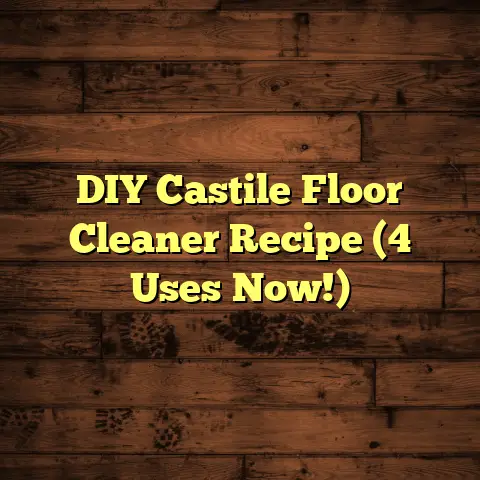Gluing Hardwood To Plywood? (5 Mistakes Costly!)
Have you ever wondered why your hardwood floors failed to deliver the beauty and durability you envisioned?
Well, chances are some common, yet easily avoidable, mistakes were made during the glue-down process.
Trust me, I’ve seen it all in my years as a flooring contractor.
Gluing hardwood to plywood seems straightforward, but it’s a minefield of potential problems if you don’t know what you’re doing.
I’m here to spill the beans on the 5 biggest, most costly mistakes I see homeowners and even some pros make when gluing hardwood to plywood.
Avoid these, and you’ll be well on your way to a floor that looks amazing and lasts for years.
1. The Importance of Proper Adhesion
Let’s get one thing straight: proper adhesion is the backbone of a successful hardwood floor installation over plywood.
It’s not just about slapping some glue down and hoping for the best.
Think of it like this: your hardwood floor is a finely tuned instrument, and the adhesive is the crucial link between the instrument and the stage (the plywood subfloor).
Without a solid connection, the whole performance falls apart!
Why is adhesion so important?
- Longevity: Proper adhesion prevents the hardwood from shifting, squeaking, or separating over time.
You want a floor that lasts decades, not just a few years. - Performance: A well-bonded floor is more resistant to impact, wear and tear, and even moisture.
- Stability: Gluing helps to stabilize the hardwood, reducing the risk of warping or buckling due to changes in humidity.
If you mess up the adhesion, you’re looking at costly repairs or even a complete floor replacement down the line.
Trust me, I’ve seen floors that look like a topographical map after just a few years because of poor adhesion.
We’re talking thousands of dollars in damage.
2. Mistake #1 – Choosing the Wrong Adhesive
This is where things often go wrong right from the start.
Not all adhesives are created equal, and using the wrong one can have disastrous consequences.
It’s like using the wrong type of oil in your car – it might seem fine at first, but eventually, things will break down.
So, what types of adhesives are we talking about?
Urethane Adhesives: These are generally considered the gold standard for gluing hardwood to plywood.
They offer excellent bond strength, flexibility, and moisture resistance.
I personally prefer using urethane adhesives for most of my projects.- Pros: High bond strength, moisture resistance, flexibility.
- Cons: Can be more expensive than other options.
-
Modified Silane Polymer Adhesives: These are another excellent choice, offering similar benefits to urethane adhesives.
They are also low in VOCs (Volatile Organic Compounds), making them a more environmentally friendly option. -
Pros: Excellent bond strength, low VOCs, good for engineered hardwood.
- Cons: Can be sensitive to temperature during application.
-
Acrylic Adhesives: These are typically less expensive than urethane or modified silane adhesives, but they may not offer the same level of performance.
They are generally better suited for engineered hardwood or softer wood species. -
Pros: Lower cost, easy to apply.
- Cons: Lower bond strength, less moisture resistance.
-
Construction Adhesives: These are a big NO-NO for hardwood flooring.
They are not designed for the specific needs of hardwood and can lead to a host of problems. -
Pros: None for hardwood flooring applications.
- Cons: Poor bond strength, can damage hardwood, may contain harmful chemicals.
What happens if you choose the wrong adhesive?
- Moisture Issues: Some adhesives are not moisture-resistant and can break down over time, leading to the hardwood delaminating from the plywood.
- Inadequate Bond Strength: The floor will start to squeak, shift, and separate.
You might even notice individual boards popping up. - Compatibility Problems: Some adhesives can react negatively with certain types of hardwood or plywood, causing discoloration or other damage.
My Recommendation: Always consult with the adhesive manufacturer’s guidelines and your hardwood supplier to ensure you’re using the right product for your specific project.
Don’t try to save a few bucks by using a cheaper adhesive – it will cost you much more in the long run.
3. Mistake #2 – Neglecting Subfloor Preparation
Think of your plywood subfloor as the foundation of your entire flooring project.
If the foundation is weak, uneven, or contaminated, the entire structure is at risk.
Proper subfloor preparation is absolutely crucial for ensuring a strong, lasting bond between the hardwood and the plywood.
What are the common subfloor preparation mistakes I see?
Ignoring Moisture Levels: This is a HUGE one.
Plywood is highly susceptible to moisture, and if it’s too damp, the adhesive won’t bond properly.
The National Wood Flooring Association (NWFA) recommends that the moisture content of the plywood should be within a certain range, typically 6-9%, depending on the species of wood.- How to check: Use a moisture meter to measure the moisture content of the plywood in multiple locations.
- What to do if it’s too high: Allow the plywood to dry naturally, use dehumidifiers, or consider replacing the plywood altogether.
-
Failing to Clean the Surface: Dust, dirt, paint, or other contaminants can prevent the adhesive from bonding properly.
-
How to clean: Vacuum the subfloor thoroughly, then use a damp cloth or mop to remove any remaining debris.
For stubborn stains, use a mild detergent solution. -
Not Checking for Levelness: An uneven subfloor will cause the hardwood to flex and bend, which can lead to cracks, squeaks, and separation.
The NWFA recommends that the subfloor be flat to within 3/16″ over a 10-foot span. -
How to check: Use a long level or a straight edge to check for high and low spots.
- How to fix: Use self-leveling compound to fill in low spots or sand down high spots.
Here’s a table summarizing acceptable subfloor flatness tolerances according to the NWFA:
What are the consequences of these oversights?
- Poor Adhesion: The adhesive won’t bond properly, leading to squeaks, shifting, and separation.
- Warping and Buckling: Moisture trapped under the hardwood can cause it to warp or buckle.
- Uneven Floor: An uneven subfloor will result in an uneven finished floor.
My Recommendation: Take the time to properly prepare the subfloor.
It’s an investment that will pay off in the long run.
Don’t cut corners on this step!
4. Mistake #3 – Incorrect Application Techniques
Even with the right adhesive and a properly prepared subfloor, you can still mess things up if you don’t apply the adhesive correctly.
It’s like having all the right ingredients for a cake but botching the baking process.
What are the common application mistakes I see?
Applying Too Much Adhesive: This can create a messy situation, with adhesive oozing up between the boards.
It can also prevent the hardwood from sitting flush against the subfloor.- How to avoid: Use the recommended trowel notch size and apply the adhesive in a thin, even layer.
-
Applying Too Little Adhesive: This will result in a weak bond and the problems we’ve already discussed.
-
How to avoid: Make sure you’re using enough adhesive to create a full, consistent bond.
-
Using the Wrong Trowel Notch Size: The trowel notch size determines the amount of adhesive that is applied.
Using the wrong size can lead to either too much or too little adhesive. -
How to avoid: Consult the adhesive manufacturer’s guidelines for the recommended trowel notch size.
-
Not Maintaining a Wet Edge: The adhesive needs to be applied while it’s still wet and tacky.
If it dries out before the hardwood is installed, the bond will be compromised. -
How to avoid: Work in small sections and install the hardwood as quickly as possible after applying the adhesive.
What are the ideal tools and techniques for optimal results?
- Notched Trowel: Use a high-quality notched trowel with the correct notch size for the adhesive you’re using.
- Spreader: Use a spreader to evenly distribute the adhesive.
- Roller: Use a heavy roller to press the hardwood firmly into the adhesive.
- Clean-Up Supplies: Keep plenty of rags and mineral spirits on hand to clean up any excess adhesive.
My Recommendation: Practice your application technique on a scrap piece of plywood before you start on the actual floor.
This will help you get a feel for the right amount of adhesive and the best way to apply it.
5. Mistake #4 – Ignoring Expansion Gaps
Hardwood is a natural material, and it expands and contracts with changes in humidity.
If you don’t allow for this movement, you’re asking for trouble.
Failing to leave expansion gaps is like building a bridge without expansion joints – eventually, the stress will cause it to crack and crumble.
Why are expansion gaps so important?
- Prevent Warping and Buckling: When hardwood expands, it needs somewhere to go.
If it’s constrained by walls or other obstructions, it will warp or buckle. - Maintain a Flat, Even Floor: Expansion gaps allow the hardwood to move freely, preventing it from pushing against adjacent boards and creating an uneven surface.
- Prevent Damage to Walls and Trim: If the hardwood expands too much, it can put pressure on the walls and trim, causing them to crack or become damaged.
How big should the expansion gaps be?
- Type of Hardwood: Different species of hardwood expand and contract at different rates.
- Width of the Room: Wider rooms will require larger expansion gaps.
- Climate: Areas with high humidity fluctuations will require larger expansion gaps.
As a general rule, you should leave an expansion gap of at least 1/4 inch (6 mm) around the perimeter of the room.
For wider rooms, you may need to increase the size of the expansion gaps to 3/8 inch (9 mm) or even 1/2 inch (12 mm).
How to determine the right size: Consult with your hardwood supplier or a qualified flooring contractor.
My Recommendation: Use spacers to ensure consistent expansion gaps around the perimeter of the room.
These spacers are inexpensive and can save you a lot of headaches down the road.
6. Mistake #5 – Skipping the Curing Time
Patience, my friends, is a virtue, especially when it comes to allowing the adhesive to cure properly.
Just because the floor looks good doesn’t mean it’s ready to be walked on.
Rushing the curing process is like taking a cake out of the oven before it’s fully baked – it might look okay on the outside, but it’s a gooey mess on the inside.
Why is curing time so important?
- Complete Bond Formation: The adhesive needs time to fully cure and form a strong, lasting bond between the hardwood and the plywood.
- Prevent Damage to the Flooring: Walking on the floor too soon can disrupt the curing process and damage the adhesive.
- Avoid Squeaks and Shifting: If the adhesive hasn’t fully cured, the hardwood can shift and squeak underfoot.
How long should you wait before walking on the floor?
The curing time depends on the type of adhesive you’re using and the environmental conditions.
Always follow the manufacturer’s guidelines for curing times.
In general, you should wait at least 24-48 hours before walking on the floor.
For heavy furniture or high-traffic areas, you may need to wait longer.
What happens if you walk on the floor too soon?
- Incomplete Bond Formation: The adhesive may not fully cure, resulting in a weak bond.
- Damage to the Flooring: The hardwood can shift and move, causing cracks, squeaks, and separation.
- Voiding the Warranty: Walking on the floor before the adhesive has fully cured may void the manufacturer’s warranty.
My Recommendation: Be patient!
Resist the urge to walk on the floor until the adhesive has fully cured.
It’s better to wait a few extra days than to risk damaging your new floor.
Here’s a quick recap table of the 5 mistakes:
Conclusion
So there you have it – the 5 most costly mistakes I see when gluing hardwood to plywood.
By avoiding these pitfalls, you can ensure a successful and long-lasting flooring installation.
Remember, attention to detail and proper methods are essential.
Don’t cut corners, do your research, and take your time.
Your beautiful hardwood floor will thank you for it!
Now go forth and create the hardwood floor of your dreams!





